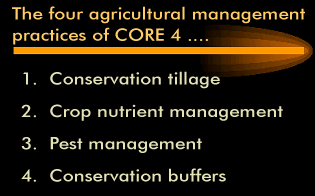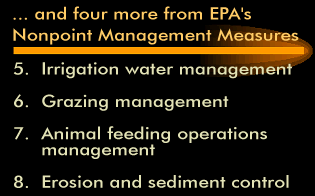Introduction
Welcome to the Agricultural Management Practices for Water Quality Protection module. This web-based training unit introduces eight basic types of agricultural practices that are suitable for reducing or minimizing water quality impacts, as part of an overall watershed approach. These practices are often called Best Management Practices, or BMPs. We based this module on two primary information sources:
CORE 4, an outreach program for the agriculture community, developed by the Conservation Technology Information Center (CTIC)
for the USDA Natural Resources Conservation Service; and
EPA's National Management Measures to Control Nonpoint Source Pollution, which is non-regulatory, national guidance for agriculture that is issued to help farmers reduce non-point source pollution.
 This module has two parts. Part 1 summarizes the use and value of the CORE 4 conservation
practices using training materials developed by CTIC. The CORE 4 program promotes reducing
non-point sources of pollution from croplands through integrated use of the following four
complementary practices:
This module has two parts. Part 1 summarizes the use and value of the CORE 4 conservation
practices using training materials developed by CTIC. The CORE 4 program promotes reducing
non-point sources of pollution from croplands through integrated use of the following four
complementary practices:
Conservation Tillage - leaving crop residue (plant materials from past harvests) on the soil surface reduces runoff and soil erosion, conserves soil moisture, helps keep nutrients and pesticides on the field, and improves soil, water, and air quality;
Crop Nutrient Management - fully managing and accounting for all nutrient inputs helps ensure nutrients are available to meet crop needs while reducing nutrient movements off fields. It also helps prevent excessive buildup in soils and helps protect air quality;
Pest Management - varied methods for keeping insects, weeds, disease, and other pests below economically harmful levels while protecting soil, water, and air quality;
Conservation Buffers - from simple grassed waterways to riparian areas, buffers provide an additional barrier of protection by capturing potential pollutants that might otherwise move into surface waters.

Part 2 details four additional agricultural BMPs that can be considered for increased protection and benefits. These supplemental agricultural BMPs are aimed at benefiting production while protecting the environment, and are highlighted in the EPA's guidance manual National Management Measures to Control Nonpoint Source Pollution from Agriculture:
Irrigation Water Management - reducing nonpoint source pollution of ground and surface waters caused by irrigation systems;
Grazing Management - minimizing the water quality impacts of grazing and browsing activities on pasture and range lands;
Animal Feeding Operations (AFOs) Management - minimizing impacts of animal feeding operations and waste discharges through runoff controls, waste storage, waste utilization, and nutrient management;
Erosion and Sediment Control - conserving soil and reducing the mass of sediment reaching a water body, protecting both agricultural land and water quality and habitat.
This is one of the 15 required modules in the Watershed Management Certificate Program
Section 1 of 35
![[logo] US EPA](https://www.epa.gov/epafiles/images/logo_epaseal.gif)